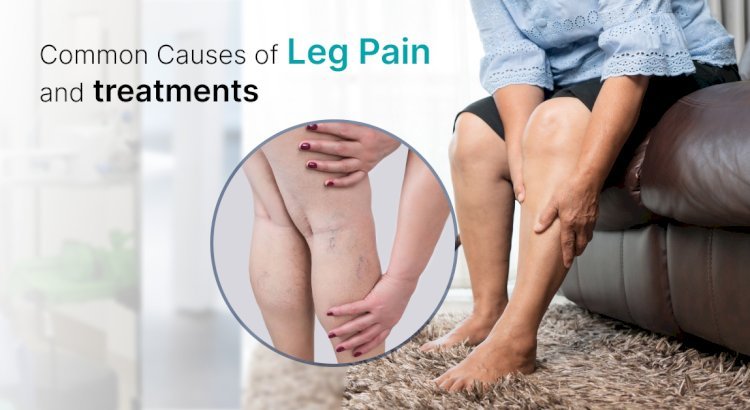Can Leg Pain Be a Warning Sign for Blood Clots? Here’s What You Need to Know

Leg pain can be a common complaint for many people, but in some cases, it could be more than just a minor inconvenience. In fact, leg pain can sometimes serve as a warning sign for a serious medical condition: blood clots. Blood clots, particularly deep vein thrombosis (DVT), can be life-threatening if left untreated. In this comprehensive guide, we will delve into the connection between leg pain and blood clots, the symptoms to watch for, and what you need to do if you suspect a blood clot.
Understanding Blood Clots and Their Types
Blood clots are clumps of blood that form when the blood changes from a liquid to a gel-like state. While clotting is a natural process that helps stop bleeding when you’re injured, clots that form inappropriately within blood vessels can lead to significant health problems.
There are two main types of blood clots to be aware of:
- Deep Vein Thrombosis (DVT): This type of clot forms in the deep veins, typically in the legs. DVT can cause pain, swelling, and redness in the affected leg and can lead to serious complications if the clot travels to the lungs.
- Pulmonary Embolism (PE): This occurs when a blood clot breaks loose from its original location and travels to the lungs, blocking blood flow. A PE is a medical emergency that can result in severe complications or even death.
Why Leg Pain Can Be a Warning Sign
Leg pain associated with blood clots often arises due to DVT. When a clot forms in a deep vein, it can obstruct blood flow, leading to increased pressure and irritation in the surrounding tissues. This irritation and obstruction are what cause the characteristic pain, swelling, and discomfort.
It’s important to note that not all leg pain is due to blood clots, and not all blood clots cause noticeable symptoms. However, recognizing the signs of DVT can be lifesaving.
Symptoms of Blood Clots in the Leg
The symptoms of a blood clot in the leg can vary from person to person, but common signs include:
- Swelling: One of the hallmark symptoms of DVT is swelling in the affected leg, often in just one leg. The swelling may be accompanied by a feeling of heaviness.
- Pain or Tenderness: The pain may feel like cramping or soreness and is often localized to the calf or thigh. It can worsen when walking or standing for long periods.
- Redness or Discoloration: The skin over the affected area may appear red, bluish, or discolored.
- Warmth: The area around the clot may feel warm to the touch.
- Visible Veins: In some cases, veins near the surface of the skin may become more prominent.
- Fever: A low-grade fever can sometimes accompany DVT.
Risk Factors for Blood Clots
Certain factors can increase your risk of developing blood clots. These include:
- Prolonged Immobility: Sitting for long periods, such as during a flight or car ride, can reduce blood flow in the legs and increase the risk of clots.
- Surgery or Trauma: Major surgeries, particularly those involving the legs or hips, and injuries can damage blood vessels, increasing the likelihood of clot formation.
- Medical Conditions: Conditions such as cancer, heart disease, or inflammatory disorders can raise the risk of blood clots.
- Pregnancy: Pregnancy increases pressure on the veins in the pelvis and legs, which can elevate clot risk.
- Hormone Therapy: Birth control pills or hormone replacement therapy can increase clotting tendencies.
- Obesity: Excess weight puts additional pressure on the veins, slowing blood flow.
- Smoking: Smoking affects blood circulation and increases clotting risk.
- Age: Older adults are at higher risk for blood clots due to reduced mobility and age-related changes in blood vessels.
- Family History: A family history of blood clots or clotting disorders can increase your risk.
Differentiating Between Blood Clots and Other Causes of Leg Pain
Differentiating between blood clots and other causes of leg pain is essential, as the underlying conditions can vary greatly in severity, treatment, and potential complications. Blood clots, specifically deep vein thrombosis (DVT), are a medical emergency, whereas other causes of leg pain, though uncomfortable, may not pose the same immediate risk. Below is a detailed explanation of some common causes of leg pain and how they compare to blood clots.
1. Muscle Cramps
Muscle cramps, often referred to as “charley horses,” are sudden, involuntary contractions of a muscle, usually in the calf or thigh. These cramps often occur due to:
- Dehydration: Insufficient fluid intake can disrupt the balance of electrolytes, leading to spasms.
- Electrolyte Imbalances: Low levels of potassium, magnesium, or calcium can trigger cramps.
- Overuse or Prolonged Sitting: Long periods of inactivity or excessive exercise can cause the muscles to spasm.
Key Differences from Blood Clots:
- Muscle cramps typically result in sharp, localized pain that resolves within minutes to hours.
- Unlike blood clots, muscle cramps do not cause swelling, redness, or warmth in the affected area.
- The pain from muscle cramps is often relieved by stretching, hydration, or massaging the muscle, whereas DVT symptoms persist and worsen over time.
2. Varicose Veins
Varicose veins are enlarged, twisted veins that usually appear on the surface of the skin, particularly on the legs. They occur due to weakened or damaged valves in the veins, which cause blood to pool and veins to bulge. Symptoms of varicose veins include:
- Aching or throbbing pain in the legs.
- A feeling of heaviness, especially after prolonged standing.
- Swelling and itching around the affected veins.
Key Differences from Blood Clots:
- The pain from varicose veins is often chronic but mild and tends to worsen with standing or sitting for long periods.
- Varicose veins are visible as raised, bluish, or purplish veins, while blood clots in DVT occur in deeper veins and are not visible.
- Blood clots may cause sudden, severe pain and swelling, whereas varicose veins develop gradually and rarely lead to emergencies unless associated with a clot (superficial thrombophlebitis).
3. Peripheral Artery Disease (PAD)
Peripheral artery disease is a condition in which narrowed arteries reduce blood flow to the extremities, typically the legs. It is caused by a buildup of fatty deposits (atherosclerosis) in the arterial walls. Symptoms include:
- Cramping or pain in the calves, thighs, or hips during physical activity (called claudication).
- Leg pain that improves with rest.
- Coldness or numbness in the legs or feet.
- Wounds or sores on the legs that heal slowly or not at all.
Key Differences from Blood Clots:
- PAD-related pain is activity-induced and subsides with rest, whereas pain from a blood clot can occur at any time and does not improve with rest.
- PAD is a chronic condition with gradual onset, while DVT pain often appears suddenly and is accompanied by swelling and skin discoloration.
- Blood clots in DVT often cause localized warmth, redness, and tenderness, which are not typical in PAD.
4. Sciatica
Sciatica is nerve pain caused by irritation or compression of the sciatic nerve, which runs from the lower back through the buttocks and down each leg. Common causes include herniated discs, bone spurs, or spinal stenosis. Symptoms include:
- Sharp, shooting pain radiating down one leg.
- Tingling, numbness, or weakness in the affected leg.
- Pain that worsens with prolonged sitting, coughing, or sneezing.
Key Differences from Blood Clots:
- Sciatica pain radiates along the path of the sciatic nerve, often starting in the lower back and moving down the leg, while DVT pain is localized to the calf or thigh.
- Sciatica pain is nerve-related and may be positional, worsening with certain movements or postures, unlike blood clot pain, which remains constant or worsens over time.
- Blood clots typically present with additional symptoms like swelling, redness, and skin warmth, which are absent in sciatica.
5. Injury or Overuse
Leg pain can also result from injuries such as strains, sprains, or overuse of muscles, tendons, or ligaments. These injuries may occur from:
- Physical trauma (e.g., a fall, sports injury).
- Repetitive movements or improper technique during exercise.
- Sudden increases in activity levels.
Symptoms include:
- Pain that is localized to the injured area.
- Swelling, bruising, or stiffness.
- Pain that worsens with movement and improves with rest.
Key Differences from Blood Clots:
- Pain from injuries is directly linked to a specific event or activity, whereas DVT pain often occurs without a clear cause.
- Blood clots cause systemic symptoms like swelling, warmth, and redness, while injury-related pain is usually confined to the area of trauma.
- Injuries respond well to rest, ice, compression, and elevation (RICE), while blood clots require immediate medical intervention.
Diagnosing Blood Clots
If a blood clot is suspected, your healthcare provider may use the following methods to confirm the diagnosis:
- Physical Examination: A doctor will check for swelling, tenderness, and discoloration in the affected leg.
- Color Doppler Ultrasound: This is the most common diagnostic tool for DVT. It uses sound waves to create images of the veins and detect clots.
- Blood Tests: Elevated levels of D-dimer, a substance released when blood clots break down, can indicate the presence of a clot.
- Imaging Tests: In some cases, CT or MRI scans may be used to detect clots in the veins or lungs.
Treatment Options for Blood Clots
Treatment for blood clots aims to prevent the clot from growing, reduce the risk of complications, and prevent new clots from forming. Common treatments include:
- Anticoagulants: Also known as blood thinners, these medications help prevent the clot from growing and reduce the risk of new clots.
- Thrombolytics: These are clot-busting medications used in severe cases to dissolve the clot.
- Compression Stockings: These can help reduce swelling and improve blood flow in the legs.
- Radiological Intervention: In rare cases, may be needed to remove the clot or place a filter in the vein to prevent clots from reaching the lungs.
Preventing Blood Clots
To reduce your risk of blood clots, consider the following preventive measures:
- Stay Active: Regular physical activity helps improve circulation and reduce the risk of clots.
- Stay Hydrated: Proper hydration prevents blood from becoming too thick.
- Avoid Prolonged Sitting: Take breaks to move around during long periods of sitting.
- Wear Compression Stockings: These can be especially helpful during travel or after surgery.
- Maintain a Healthy Weight: A balanced diet and regular exercise can reduce pressure on your veins.
- Quit Smoking: Smoking cessation improves overall vascular health.
- Follow Medical Advice: Take medications as prescribed and attend regular check-ups if you have risk factors for clots.
When to Seek Medical Attention
It’s important to seek immediate medical attention if you experience:
- Sudden, severe leg pain or swelling.
- Redness or warmth in the affected leg.
- Difficulty breathing or chest pain, which could indicate a pulmonary embolism.
Conclusion
Leg pain should never be ignored, especially if it’s accompanied by symptoms like swelling, redness, or warmth. While not all leg pain is due to blood clots, recognizing the warning signs and seeking prompt medical attention can be lifesaving. Understanding your risk factors and taking preventive measures can help you stay healthy and reduce the risk of complications. Always consult a healthcare provider for persistent or unexplained leg pain to ensure timely diagnosis and treatment.
What's Your Reaction?













